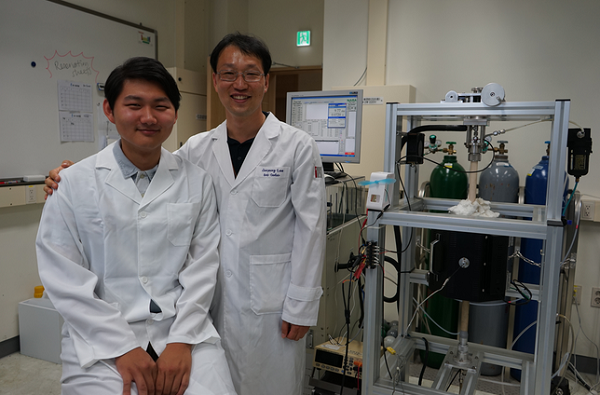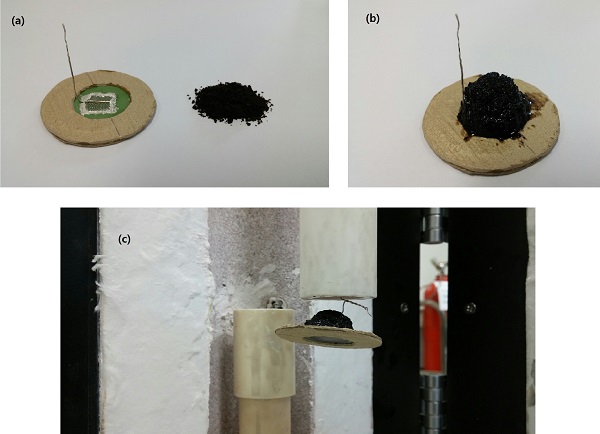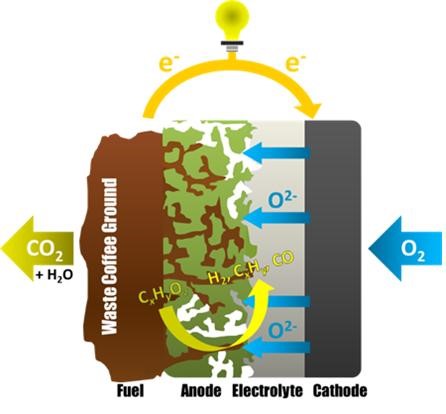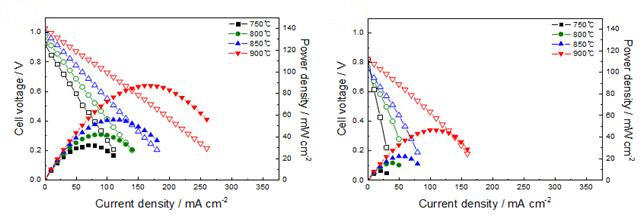Media Center
A multimedia mosaic of moments at GIST
GIST Excellence
[Press Release] A team led by Prof. Jaeyoung Lee produced electricity from old coffee grounds
- 엘리스 리
- REG_DATE : 2015.08.07
- HIT : 880
Produce electricity by drinking coffee

School of Environmental Science and Engineering professor Jaeyoung Lee (right) and a Ph.D. candidate Han Saem Jang
Korean researchers have succeeded in powering a carbon fuel cell, which is the next-generation high-temperature fuel cells, by taking advantage of the used coffee grounds. This performance is expected to offer new possibilities as an energy source while contributing to environmental protection by providing a stable electric power supply through recycled coffee grounds.
GIST"s School of Environmental Science and Engineering professor Jaeyoung Lee led the team and Ph.D. candidate Han Saem Jang performed the research. The research was supported by the New and Renewable Energy Technology Development project for direct carbon fuel cell technology development that was funded by the Korea Institute of Energy Technology Evaluation and Planning (KETEP), which is under the Ministry of Industry. Their paper “Direct power generation from waste coffee grounds in a biomass fuel cell” has been published in the online version of Journal of Power Sources on August 1, 2015.
Current annual world coffee consumption is over 8.8 million tons (USDA-2014) but utilizing that tremendous amount of used coffee grounds is extremely low. Even if recycled, it is difficult to use the total amount of wasted coffee ground. However, there has been numerous research on using coffee grounds as additives or as modifications for bio-fuels, but there are still technical challenges to overcome, which include the disposal of newly generated waste after a single use and issues of energy being lost during the modification process.

(a) Unipolar (left) and naturally dried waste coffee grounds. (b) Gel is made from mixing waste coffee grounds and ethylene glycol and placed on the unipolar. (c) Unipolar is then connected to an alumina reactor.
The team succeeded in obtaining excellent performance from the carbon fuel cell that was powered by the used coffee grounds—and done so in an environmentally-friendly and cost-effective manner. With such results, the possibility of utilizing biomass (such as coffee powder) as an energy source becomes more feasible.
In previous studies of carbon fuel cell, conventional biomass materials were used that often required modification through carbonization or gasification, but the GIST team made no special modifications to their used coffee grounds that they used as fuel except for drying them out naturally over three days.
As a result, the carbon fuel cell"s power was 88% higher when compared to the better quality carbon sources, such as carbon black that are generally used as fuel. The reason for the leap in power was identified as the internal modification of the used coffee grounds while operating the carbon fuel cell.
In addition, there was only a small amount of ash left after producing the electricity. The waste byproduct is mainly water vapors and high purity carbon dioxide, which makes this an excellent fuel cell technology.

Figure 1. Through internal modification of waste coffee grounds, H2, CxHy, CO gaseous fuels are formed on the surface of anode. O2 is supplied to cathode and turn into oxygen ions (O2-) which then passes through electrolyte then react with gaseous fuels of anode and produce electricity.

Figure 2. Waste coffee grounds (left) and carbon Black (right) shows the performance analysis. These shapes (■, ●, ▲, ▼) indicate power density. Results show operation by waste coffee grounds showing twice higher performances than carbon black.
Professor Jaeyoung Lee said, “These results are expected to contribute to the regional small-scale distributed power supply utilizing the old coffee grounds as a green energy source. Also, when considering domestic coffee consumption per year (120,000 tons - 2014) and electricity consumption per year (4,800 kWh - 2013), we can expect carbon fuel cell power generation technology utilizing old coffee grounds to supply power to 35,000 households or 6,000 places of small and medium-sized coffee shops per year.”